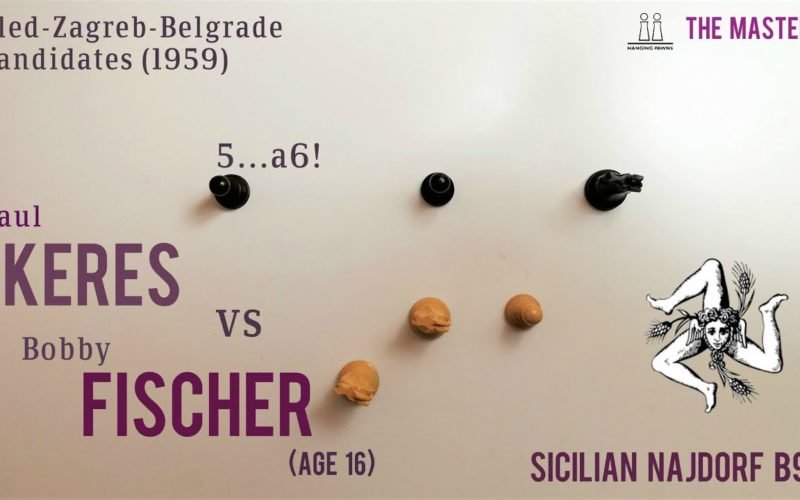Paul Keres vs Robert James Fischer, Sicilian Defense, Najdorf B99
1959 Bled-Zagreb-Belgrade Candidates Tournament, Round 1
Bobby Fischer was just 16 in 1959., and he qualified for the biggest tournament in the chess calendar (apart from the world championship match), the candidates tournament. It was held in former Yugoslavia, which meant that he had to travel to a whole other continent alone (his mother had already moved away from their flat in NY). This had to be stressful for him, no matter how experienced he already was.
Bobby was the youngest of all the candidates (and the least experienced). He only scored 12.5/28 in the end, but even that is a great result for someone his age, who’d been playing top level chess for only a year or two, while all the other players have been superstars for decades even. Mikhail Tal won in the end, and he was the one who challenged Mikhail Botvinnik for the world championship title (he won 12.5-8.5).
Here are the final standings of the 1959 Bled-Zagreb-Belgrade Candidates Tournament:
Mikhail Tal 20/28
Paul Keres 18.5/28
Tigran Vartanovich Petrosian 15.5/28
Vasily Smyslov 15/28
Robert James Fischer 12.5/28
Svetozar Gligoric 12.5/28
Fridrik Olafsson 10/28
Pal Benko 8/28
This is a game from round one. Bobby Faced the legend of Estonian and Soviet chess – Paul Keres. A very strong grandmaster with years of experience. Paul opened with e4 and Bobby Fischer replied with the fighting Sicilian Najdorf. They played a theoretical line until Keres slowed down, and, instead of pushing his kingside pawns, started passively developing. This gave Fischer the initiative and enough time to start a kingside pawn avalanche. He got a better position, and Keres decided to enter a highly complex variation in which he sacrifices a queen. It was a bad decision, and Fischer emerged material up and clearly winning, materially, strategically and positionally.
The funny thing is that the game ended in checkmate, which is super rare at high level. In an endgame in which Fischer had the queen vs knight and rook, Keres was forced to give up the knight to stop one of the pawns, and managed to compromise his king even more in the process. Bobby checked the king to improve the position of his queen and Keres blundered mate in 1.
*The Najdorf Sicilian is a very complex opening and it has numerous variations, each branching out and going for 15-30 in depth theoretically. If you’d like to study it, I recommend looking at the games of Maxime Vachier-Lagrave, who is the biggest expert on the opening today.
Game Moves:
1. e4 c5 2. Nf3 d6 3. d4 cxd4 4. Nxd4 Nf6 5. Nc3 a6 6. Bg5 e6
7. f4 Be7 8. Qf3 Qc7 9. O-O-O Nbd7 10. Be2 b5 11. Bxf6 Nxf6
12. e5 Bb7 13. exf6 Bxf3 14. Bxf3 Bxf6 15. Bxa8 d5 16. Bxd5
Bxd4 17. Rxd4 exd5 18. Nxd5 Qc5 19. Re1+ Kf8 20. c3 h5 21. f5
Rh6 22. f6 gxf6 23. Nf4 h4 24. Rd8+ Kg7 25. Ree8 Qg1+ 26. Kd2
Qf2+ 27. Ne2 Rg6 28. g3 f5 29. Rg8+ Kf6 30. Rxg6+ fxg6
31. gxh4 Qxh2 32. Rd4 Qh1 33. Kc2 Ke5 34. a4 Qf1 35. Nc1 Qg2+
36. Kb3 bxa4+ 37. Ka3 Qc2 38. Nd3+ Kf6 39. Nc5 Qc1 40. Rxa4
Qe3 41. Nxa6 f4 42. Rd4 Kf5 43. Nb4 Qe7 44. Kb3 Qxh4 45. Nd3
g5 46. c4 Qg3 47. c5 f3 48. Kc4 f2 49. Nxf2 Qxf2 50. c6 Qxb2
51. Kc5 Qc3+ 52. Kd5 g4 53. Rc4 Qe5# 0-1

